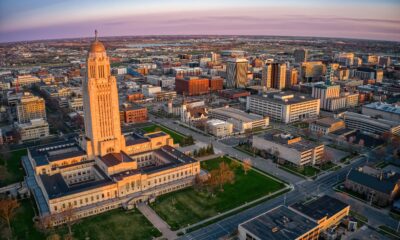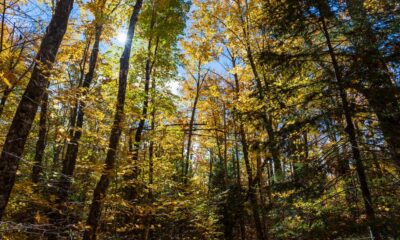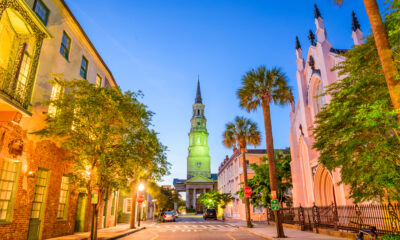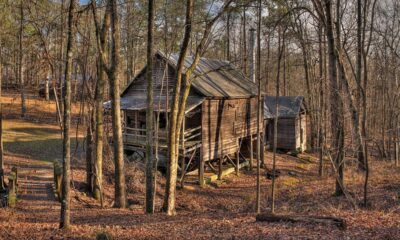West Virginia
Bombs over Blair Mountain: When the U.S. government dropped explosives on its own citizens
Published
3 weeks agoon

The Battle of Blair Mountain’s Armed Miner Rebellion
West Virginia coal miners lived like slaves in 1912. Coal firms ran whole towns, paid in fake money, and hired gun thugs to crush unions.
When Sheriff Sid Hatfield stood up for miners, company men shot him dead in broad daylight. That lit the fuse.
In August 1921, ten thousand armed miners with red bandanas marched from near the state capitol. They faced machine guns, bombs dropped from planes, and finally U.S. troops sent by the president.
The Battle of Blair Mountain marks America’s largest armed labor uprising since the Civil War.
Today, you can trace this epic struggle at the West Virginia State Capitol’s museum, where mining exhibits bring this forgotten rebellion to life.

Coal Companies Trapped Miners in a System of Total Control
Coal companies in early 1900s West Virginia owned everything in mining towns. They ran the houses, stores, schools, churches, and local law.
Miners got paid in “scrip” instead of real money, which they could only use at overpriced company stores. Workers had to sign “yellow dog contracts” promising never to join a union.
Company-hired guards patrolled the towns, keeping union organizers out and miners in line. If a miner talked about unions, the company kicked his whole family out of their home.

Thousands of Miners Walked Off the Job in 1912
Trouble started in March 1912 when Paint Creek miners got tired of earning less than union miners just miles away.
By April, 7,500 miners from Paint Creek and nearby Cabin Creek stopped working, asking for better pay and union rights. Coal bosses quickly hired 300 Baldwin-Felts detectives with rifles to break the strike.
Companies forced striking families out of their homes into tent colonies through harsh weather. The Socialist Party helped by giving miners 6 machine guns, 1,000 rifles, and 50,000 bullets for protection.

Armed Train Terrorized Miners’ Tent Colonies
Baldwin-Felts agents built an armored train car called the “Bull Moose Special” with machine guns inside.
On February 7, 1913, they drove this armed train through the Holly Grove tent colony with its lights off, shooting into tents where families slept.
Francis Francesco Estep, an Italian miner, died from a gunshot to the face while trying to protect his pregnant wife. News of this attack spread across the country.
Governor William Glasscock sent 1,200 state troops who mostly took weapons from miners rather than stopping company violence.

Small Town Police Chief Stood Up for Union Men
The town of Matewan became a key battleground on May 19, 1920.
Thirteen Baldwin-Felts detectives came to kick union miners out of Stone Mountain Coal Company housing. Police Chief Sid Hatfield and Mayor Cabell Testerman refused to let this happen in their town.
When the detectives showed fake eviction papers, Hatfield confronted Albert Felts directly. Meanwhile, armed miners quietly took positions in windows, doorways, and rooftops along Mate Street.
By July 1920, over 90% of Mingo County miners had joined the union despite company threats.

Gunfight in Matewan Left Ten Men Dead
A fierce gun battle broke out on Matewan’s main street that May afternoon, lasting about 15 minutes and killing ten men. Seven Baldwin-Felts detectives died in the shootout, including brothers Albert and Lee Felts.
Mayor Testerman and two miners also died. Sid Hatfield became a hero to miners across West Virginia for standing up to the feared detective agency.
For the first time, someone beat the “invincible” Baldwin-Felts agents, giving miners hope that the companies weren’t all-powerful.

Violence Spread Through the Tug Valley in 1921
By mid-May 1921, fighting spread throughout the Tug River Valley as union miners attacked non-union mines. The Mingo County sheriff reported that “murder by lying in wait and shooting from ambush has become common.”
The governor ordered martial law, but miners felt only they faced punishment.
Guards arrested hundreds of miners for small violations while mine guards went free for similar or worse actions.
Coal companies brought in replacement workers and pushed ex-strikers to sign anti-union pledges, reopening about 80% of mines during the conflict.

Courthouse Murder Sparked Miner Outrage
On August 1, 1921, Sid Hatfield and his friend Ed Chambers went to the McDowell County courthouse in Welch for a trial.
As they climbed the courthouse steps with their wives, Baldwin-Felts agents including Charles Lively, who had snuck into the miners’ group, ambushed them. Hatfield died right away from shots to his arm and chest.
After Chambers fell wounded, agent Lively walked down the steps and shot him point-blank in the back of the head. The killing of their hero in broad daylight pushed miners past their breaking point.

Miners Rallied at the State Capitol Demanding Justice
Just six days after Hatfield’s murder, 5,000 angry miners gathered at the West Virginia State Capitol in Charleston.
United Mine Workers leader Frank Keeney told the crowd, “The only way you can get your rights is with a high-powered rifle!”
When Governor Ephraim Morgan rejected their demands for protection and justice, miners decided to take matters into their own hands.
That night, miners started gathering at Lens Creek, just 10 miles from Charleston, planning an armed march to free jailed union members and end company rule.

Red Bandanas Became the Symbol of Miner Rebellion
Between August 20-24, 1921, thousands of armed miners gathered near Marmet, just outside Charleston. They tied red bandanas around their necks to know each other, earning the nickname “Red Neck Army.”
World War I veterans organized the miners into military-style units with guards, patrols, and password systems. The miners took over Chesapeake and Ohio freight trains, even calling one the “Blue Steel Special.”
They planned to march 60 miles to Mingo County to free jailed union miners and break the coal companies’ armed guard system.

The Largest Armed Uprising Since the Civil War Erupted
On August 25, 1921, Logan County Sheriff Don Chafin positioned 3,000 deputies and mine guards along Blair Mountain. Coal companies paid for this massive private army and set up machine gun nests guarding mountain passes.
They even hired private planes to drop homemade bombs and poison gas on the advancing miners. For five days, the mountain echoed with gunfire as nearly a million rounds flew between both sides.
Miners used their military experience to advance up the ridges while Chafin’s forces held defensive positions in what became the largest armed conflict on American soil since the Civil War.

Federal Army Arrived to End the Miners’ March
President Warren Harding threatened to send federal troops and Army bombers on August 26, 1921. By September 2, 2,500 U.S. Army troops arrived under General Harry Bandholtz’s command.
Many miners were military veterans themselves and refused to fight against the American flag. They surrendered peacefully rather than battle U.S. soldiers.
Authorities arrested over 550 miners and union leaders on serious charges including murder, conspiracy, and treason against West Virginia. Though most eventually went free, the coal companies had won.
Union organizing in the coalfields was crushed for more than a decade afterward.

Visiting West Virginia State Capitol, West Virginia
The West Virginia State Capitol at 1900 Kanawha Boulevard East connects you to the Coal Wars history when 10,000 armed miners marched from here toward Blair Mountain in 1921.
You can take free guided tours Monday-Friday 9:30am-3:30pm and Saturdays 1pm-4pm by calling (304) 558-4839. The State Museum is also free and open Tuesday-Saturday 9am-5pm.
Parking costs $0.25 per half-hour but it’s free after 5pm weekdays and all weekends.
This article was created with AI assistance and human editing.
Read more from this brand:
John Ghost is a professional writer and SEO director. He graduated from Arizona State University with a BA in English (Writing, Rhetorics, and Literacies). As he prepares for graduate school to become an English professor, he writes weird fiction, plays his guitars, and enjoys spending time with his wife and daughters. He lives in the Valley of the Sun. Learn more about John on Muck Rack.


Here Are 12 Things People from West Virginia Do That Seem Insane To Everyone Else

Here Are 12 Things People from Washington Do That Seem Insane To Everyone Else

Here Are 12 Things People from Virginia Do That Seem Insane To Everyone Else

New Mexico Albuquerque International Balloon Fiesta wrap-ups and fall arts

Mississippi Natchez Trace fall festivals and music events

12 Reasons Why You Should Never Ever Move to Florida

Best national parks for a quiet September visit

In 1907, Congress forced Roosevelt to put God back on U.S. coins. Here’s why.

The radioactive secret White Sands kept from New Mexicans for 30 years

America’s most famous railroad photo erased 12,000 Chinese workers from history
Trending Posts

 Pennsylvania3 days ago
Pennsylvania3 days agoHere Are 12 Things People from Pennsylvania Do That Seem Insane To Everyone Else

 North Carolina4 days ago
North Carolina4 days agoHere Are 12 Things People from North Carolina Do That Seem Insane To Everyone Else

 Nebraska6 days ago
Nebraska6 days agoHere Are 12 Things People from Nebraska Do That Seem Insane To Everyone Else

 Maine5 days ago
Maine5 days agoThe ruins of a town that time forgot are resting in this Maine state park

 New York4 days ago
New York4 days agoHere Are 12 Things People from New York Do That Seem Insane To Everyone Else

 South Carolina2 days ago
South Carolina2 days agoHere Are 12 Things People from South Carolina Do That Seem Insane To Everyone Else

 Ohio4 days ago
Ohio4 days agoHere Are 12 Things People from Ohio Do That Seem Insane To Everyone Else

 Georgia5 days ago
Georgia5 days agoThis plantation’s slave quarters tell Georgia’s slowest freedom story
